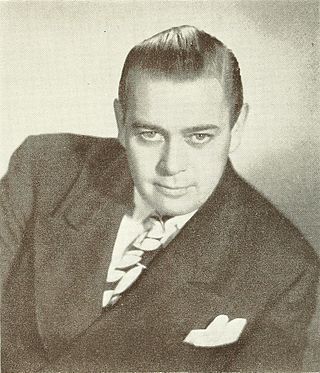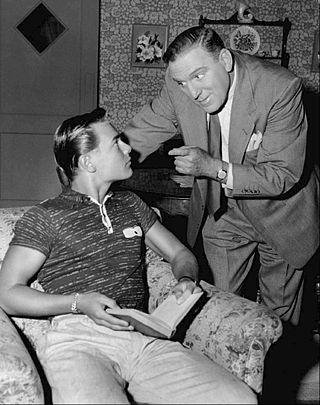Related Research Articles

John Morton Downey, also known as Morton Downey, was an American singer and entertainer popular in the United States in the first half of the 20th century, enjoying his greatest success in the late 1920s and early 1930s. Downey was nicknamed "The Irish Nightingale".
The Alan Young Show is an American radio and television series presented in diverse formats over a nine-year period and starring English-born comedian Alan Young.
Hollywood Screen Test is an American talent show that aired on ABC from 1948 to 1953. This program holds the distinction as the first regularly broadcast television series by the American Broadcasting Company.

The Life of Riley is an American radio situation comedy series of the 1940s that was adapted into a 1949 feature film, as well as two different television series, and a comic book.

Wilbur Hatch, was an American music composer who worked primarily in radio and television. He was born in Mokena, Illinois, and died in Studio City, California.
The Philco Television Playhouse is an American television anthology series that was broadcast live on NBC from 1948 to 1955. Produced by Fred Coe, the series was sponsored by Philco. It was one of the most respected dramatic shows of the Golden Age of Television, winning a 1954 Peabody Award and receiving eight Emmy nominations between 1951 and 1956.

John Conte was an American stage, film and TV actor, and television station owner.

Ford Star Jubilee is an American anthology series that originally aired monthly on Saturday nights on CBS at 9:30 P.M., E.S.T. from September 24, 1955, to November 3, 1956,. The series was approximately 90 minutes long, broadcast in black-and-white and color, and was typically telecast live. Ford Star Jubilee was sponsored by the Ford Motor Company.
Actors Studio is an American television series that was hosted by Marc Connelly. It originally aired on ABC from September 26, 1948 to October 26, 1949 and then on CBS from November 1, 1949, to June 23, 1950. It was one of the first series to be picked up by a network after being cancelled by another network. CBS departed from its own precedent when it took the World Video-owned series. Until then it had not shown any sustaining programs that were not owned by CBS.

Star Time is an American variety series that aired on the DuMont Television Network from September 5, 1950, to February 27, 1951, and starred singer-actress Frances Langford. It was broadcast from 10 to 11 p.m. on Tuesdays.
The Chevrolet Tele-Theatre is an American anthology series that aired live on NBC Mondays at 8 pm EST from September 27, 1948 to June 26, 1950. The program presented both news headlines and live dramatic performances of either original plays or works adapted for television from the stage. Sometimes the show was referred to as Chevrolet on Broadway or The Broadway Playhouse; particularly when the program was presenting an adapted stage work from New York City's theatre scene.
Philip Morris Playhouse is a 30-minute old-time radio dramatic anthology series.
Faith Baldwin Romance Theatre is a 1951 half-hour dramatic American television anthology series hosted by writer Faith Baldwin. The show aired from January 20 to October 20, 1951.
This Is Show Business is an American variety television program that was broadcast first on CBS and later on NBC beginning July 15, 1949, and ending September 11, 1956. It was CBS-TV's first regular series broadcast live from coast to coast. It was originally titled This Is Broadway.
Hollywood Opening Night is an American anthology television program that was broadcast on CBS in 1951-1952 and on NBC in 1952-1953. The NBC version was the first dramatic anthology presented live from the West Coast. Episodes were 30 minutes long.
Roberta Quinlan is an American musician.
Holiday Hotel is. an American television musical revue that was broadcast on ABC from March 23, 1950, until June 28, 1951 or October 4, 1951.
A Couple of Joes is an American television variety program that was broadcast locally in New York City beginning in August 1949. It ran on ABC from October 27, 1949, until July 12, 1950. The program featured comedy, music, and participation by viewers.
Inside U.S.A. With Chevrolet is an American television revue-style variety program that was broadcast on CBS September 29, 1949 - March 16, 1950. The program was not related to the book with that title or the Broadway revue of the same title.
Vanity Fair is an American daytime television talk show, the first CBS daytime TV program targeted at women. It began on October 12, 1948, and ended on November 2, 1951.
References
- 1 2 3 4 Cox, Jim (10 January 2014). Musicmakers of Network Radio: 24 Entertainers, 1926-1962. McFarland. p. 115. ISBN 978-0-7864-8962-6 . Retrieved May 27, 2022.
- 1 2 McNeil, Alex (1996). Total Television: the Comprehensive Guide to Programming from 1948 to the Present (4th ed.). New York, New York: Penguin Books USA, Inc. p. 701. ISBN 0-14-02-4916-8.
- ↑ "Sponsor warns" (PDF). Broadcasting. February 12, 1951. p. 58. Retrieved May 27, 2022.
- ↑ "TV shows go 'over there'" (PDF). Broadcasting. September 17, 1951. p. 85. Retrieved May 27, 2022.
- ↑ Terrace, Vincent (2011). Encyclopedia of Television Shows, 1925 through 2010 (2nd ed.). Jefferson, N.C.: McFarland & Company, Inc., Publishers. p. 708. ISBN 978-0-7864-6477-7.
- 1 2 "Mohawk uses a new broom" (PDF). Sponsor. September 11, 1950. pp. 28–29, 50. Retrieved May 27, 2022.
- ↑ "Musical Variety (Continued)". Ross Reports. September 11, 1949. p. 9. Retrieved August 6, 2024.
- 1 2 Gould, Jack (May 29, 1949). "Programs in Review: 'Mr. I. Magination' — Songs by Downey — 'Blind Date' — A Variety Revue" . The New York Times. p. X 9. Retrieved August 6, 2024.
- ↑ "Capsule Comment". Billboard. September 15, 1951. p. 13. Retrieved May 27, 2022.
- 1 2 "TV leads Mohawk to radio" (PDF). Sponsor. March 26, 1951. pp. 36, 64–65. Retrieved May 27, 2022.